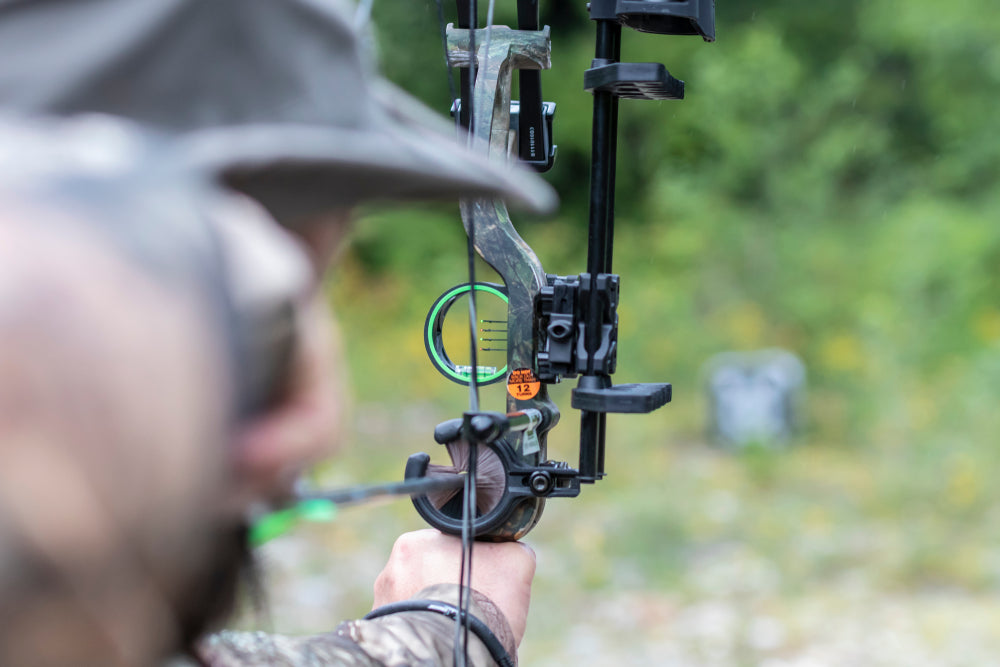
How to Get Into Compound Archery in 4 Steps
So you’re looking to become a compound archer? Welcome! We’ve developed this comprehensive guide as a resource you can use to not only learn archery basics when starting out, but also to return to over time for helpful tips and refreshers.
Before you get started reading through our tips for archery beginners, although you’re probably already aware, you should know that there are two overarching (pun intended) types of archery: compound archery and recurve archery. They’re each named for the types of bows they use, compound bows and recurve bows, respectively.
Compound vs. Recurve Archery
While compound bows have only been around since 1966, their extra system of strings, cables, and cams helps them “compound” the force of the shot, or shoot with more draw weight with equal effort to a comparable recurve bow. Compound bows also provide “let-off”. That is, “when the shooter pulls the string beyond the peak draw weight, at this point, the cams make it easier to keep pulling the string.”
While there are other differences between recurve bows and compound bows, this added draw weight and easier shooting experience are two of the most important, and together, they’ve helped compound archery become the preferred type of bowhunters, target shooters, and more.
With that important distinction out of the way, let’s now uncover 4 important archery tips and tricks for beginners so you can begin your archery journey off on the right foot.
1. Understand the Sport
The first step in developing mastery of how to do something is to understand what it is that you’re trying to achieve. When it comes to becoming a pro at compound archery, there are several important things you need to understand.
Essential Equipment
- Bows & Arrows: You can’t shoot without a bow or arrow. While all compound bows share similar mechanics and parts, not all bows are created equal. There are also various types of arrows to choose from, including those made from carbon, wood, and aluminum.
- Bow Sights: Most compound bows come with bow sights, but these essential items must be used with a compound bow.
- Bow Releases: These handy devices make it easier to shoot by holding the bow string, thus releasing pressure on the shooting finger.
- Arm Guards: Trust us — you’ll want one of these, which shields your inner arm from being hit with the bow string upon releasing your arrow.
- Quivers: These often come with the purchase of a compound bow, but if not, you’ll want to grab one. They come in different types, but the concept is the same: quivers allow you easy access to your arrows.
- Virtual Archery Practice Gear: A virtual archery training bow can help you develop mastery of the sport with very little safety risk, all from the comfort of your own home!
Hungry for more information? Archery pro Gregory Johnson’s must-read blog post entitled “Archery for Beginners: How to Get Started” does a great job of explaining many of these archery essentials in greater detail.
Finding an Archery Range
You’ll need to find a nearby archery range if you want to develop archery skills. Joining an archery club can also be extremely helpful. If you have the ability to practice archery safely in your backyard with a target, that is also a great option.
Archery Techniques
Among the most essential archery hunting tips for beginners is this: learn a proper archery stance and shooting technique. Doing so is absolutely essential to both your safety and your efficacy as a compound archer.
It’s so important, we’ve also included this helpful guide on how to shoot a compound bow, courtesy of Field & Stream.
Safety & Ethical Considerations
Safety is extremely important. In fact, if you take anything away from this blog post, it should be this: archery is a fun and rewarding but dangerous sport. Safety should always be top priority; both your safety and the safety of those around you.
If you’re getting into compound bowhunting, there are also ethical hunting practices you’ll need to follow.
2. Practice, Practice, Practice
Once you’ve found an archery range to practice at and a community of other archers to guide you, whether through friends or a local archery club, it’s time to start practicing your shooting. Remember, practice makes perfect (or nearly perfect anyway)!
There’s no shortcut to developing and mastering archery skills. But there are plenty of ways to practice other than hitting the shooting range. Case and point: Accubow’s virtual archery app — to be used in conjunction with our realistic training bows, like the Accubow 2.0.
3. Learn From the Pros
We recommend taking professional archery lessons. In fact, if you can handle the expense, it may be a good idea to start with professional lessons. After all, it’s one thing to read about how to shoot. It’s another thing entirely to experience it for yourself.
4. Set Goals
Have you ever done any type of strength training? If so, then you know that making gains requires holding yourself accountable and setting challenging yet achievable goals. Raising the bar little by little for yourself will help you develop archery proficiency more easily and quickly than if you were to practice without any goals.
Learn Archery From Home With Accubow
Looking to get your feet wet as a beginner archer in a low-stakes setting — your very own home? Explore high quality archery training devices at AccuBow today.